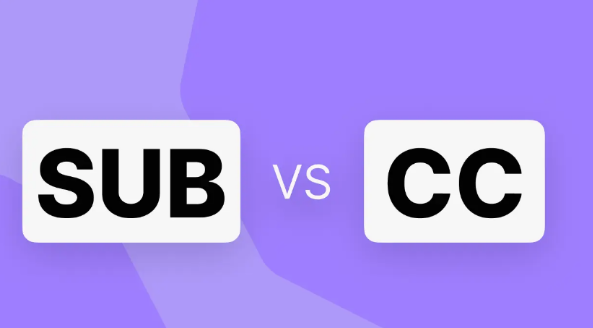As we delve into the intricacies of video accessibility, a persistent question emerges: What’s the difference between closed captions and subtitles? This inquiry takes us on a journey through the evolution of these timed text solutions, uncovering the layers that distinguish closed captions from subtitles.
Understanding Timed Text: A Synchronized Foundation
At the heart of this exploration lies the concept of timed text—a text-based file intricately woven with timing information. This synchronization facilitates the alignment of transcribed dialogue and sound with specific timestamps in media. Both closed captions and subtitles fall under the umbrella of timed text, setting the stage for a deeper analysis.
Decoding Closed Captions: From Mandates to Varieties
Closed captions made their debut in the early 1970s with a specific purpose—to cater to D/deaf and hard of hearing television viewers. Over the years, they evolved into a mandated requirement for broadcast television in the United States. Captions serve as a textual transcript of a video’s dialogue, sound effects, and music. This makes them a vital tool for not only the D/deaf and hard of hearing audiences but also a broader viewer base.
The landscape of closed captions is further nuanced by the introduction of 608 and 708 captions. The former, known as 608 closed captions, was the standard for analog television transmission. In contrast, the latter, 708 closed captions, emerged as the newer standard for digital television. The distinctions between these two types highlight the evolution of closed captioning standards, each with its own set of features and compatibilities.
Unveiling Subtitles: A Historical Perspective
Subtitles, on the other hand, have a longer history dating back to the 1930s. They were introduced during the transition from silent films to “talkies” to accommodate foreign audiences unfamiliar with the language used in a film. Subtitles provide a textual translation of a video’s dialogue, assuming that the viewer can hear the audio but might not understand the language.
Traditionally, subtitles are designed for viewers who can hear the audio but need assistance in comprehending a different language. However, an exception exists for subtitles tailored for the D/deaf and hard of hearing, which assume the viewer cannot hear the audio or understand the language.
Distinguishing Non-SDH and SDH Subtitles: Beyond the Basics
Within the realm of subtitles, further distinctions emerge. Non-subtitles for the D/deaf and hard of hearing (non-SDH), often referred to simply as “subtitles,” cater to viewers who can hear the dialogue and non-dialogue information but struggle with understanding the language. These subtitles transcribe only the dialogue, and when time allows, on-screen graphics or words may also be transcribed for comprehensive translation.
In contrast, subtitles for the D/deaf and hard of hearing (SDH) assume that the end user cannot hear the dialogue. SDH subtitles go beyond mere dialogue transcription, including crucial non-dialogue information such as sound effects, music, and speaker identification. Originally designed for viewers who cannot understand the language, SDH subtitles are now increasingly used in place of captions on some video platforms and services.
Forced Narrative Subtitles: Clarifying the Narrative
Adding another layer to the subtitle landscape is forced narrative (FN) subtitles, also known as forced subtitles. These subtitles serve a unique purpose—clarifying pertinent information meant to be understood by the viewer. FN subtitles are overlaid text used to elucidate dialogue, burned-in texted graphics, and other information that may not be explicitly explained or easily understood by the viewer.
Why the Confusion? Global Variances and the Rise of SDH
Captions and subtitles are infamous for being entangled in confusion, and several factors contribute to this conundrum. Global differences in terminology play a significant role. Outside of the United States and Canada, particularly in the UK, Ireland, and many other countries, video subtitling and captioning are often considered synonymous. The term “video subtitling” doesn’t distinguish between subtitles used for foreign language translation and captioning used for D/deaf and hard-of-hearing audiences.
The increased usage of SDH further adds complexity to the closed caption vs. subtitles discourse. Originally designed to assist viewers who cannot understand the language, SDH subtitles have found their way into diverse platforms, sometimes replacing traditional captions. This shift blurs the lines between the two, contributing to the prevailing confusion.
Conclusion
In conclusion, the difference between closed captions and subtitles extends far beyond a mere play of words. It involves historical contexts, technological standards, and evolving viewer expectations. As we navigate this complex landscape, it becomes clear that understanding these subtleties is imperative for both content creators and viewers.
In the evolving landscape of video content consumption, the distinction between closed captions and subtitles continues to shape how we experience and comprehend media. Whether it’s the meticulous synchronization of timed text or the evolving standards in closed captioning and subtitling, each component contributes to an inclusive and diverse viewing experience. So, the next time you ponder the difference between closed captions and subtitles, remember that it’s not just about words on the screen; it’s about enhancing accessibility and ensuring that everyone, regardless of hearing abilities or language barriers, can engage with content in meaningful ways.

